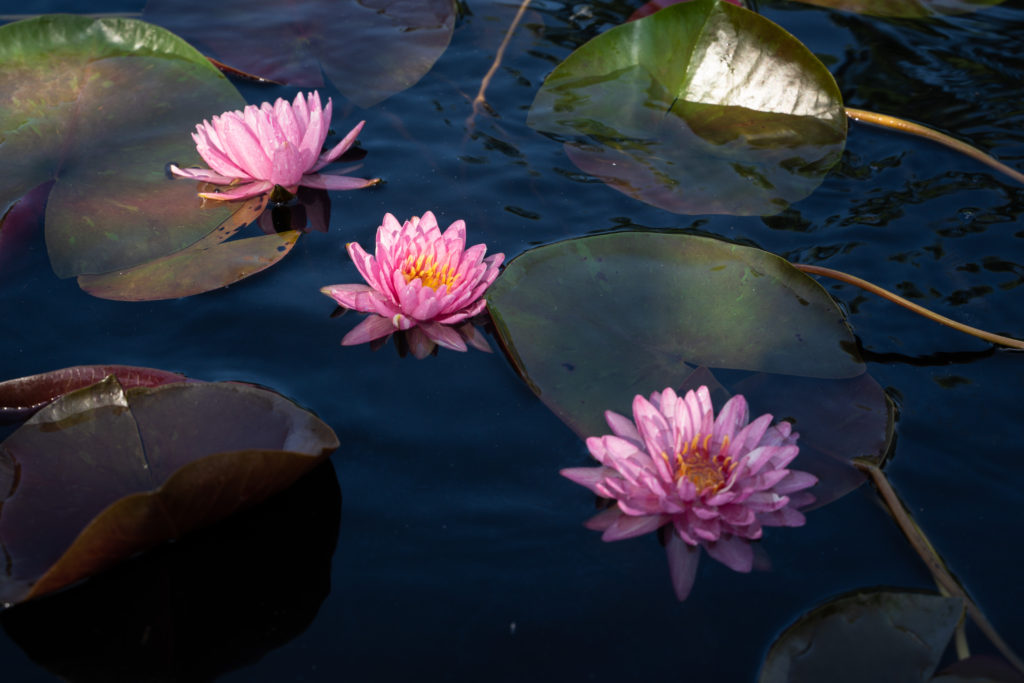
See the First Waterlily Blooms!
Naples Botanical Garden
May 15, 2019
If you concentrate long enough, you could witness a historic moment here at the Garden: the first blooms of the 2019 New Waterlily Competition have debuted, and are expected to flower for the next 6 months.
New waterlily varieties are slowly emerging from the cool, wavy depths of their aquatic beds in the Garden. Our advice is to keep your eyes open, and be willing to learn something new from this iconic plant.
With the initial phases of propagation complete, it’s hard to believe that this is only the beginning of the journey. The competition officially starts June 1. Follow our updates, and be the among the first audience to witness the growth of these unique varieties!

Hybrid Waterlilies 101
One month ago, 25 hybrid plants of the Nymphaea genus arrived from contestants around the world, finding their way to the aquatic nursery at Naples Botanical Garden. If you’re new to water gardening, here is a short lesson on what it means to grow Hybrid Waterlilies:
First, to make hybrid plants, two plant varieties must be cross-pollinated. For hybrid waterlilies, this entails introducing the pollen of one waterlily to the stigma of another waterlily. As a result, the waterlily produces a seed that contains desired qualities of both plants. It can take years to produce a successful, desired plant.
In this competition, hybridizers—the official term for participants who created each hybrid specimen—carefully chose which plants to cross-pollinate, with particular results in mind.
After successfully producing one hybrid plant, hybridizers entered plant specimens in the 2019 competition as rhizomes from mature plants. Rhizomes are thick, horizontal roots that emerge at the end of a life cycle of a parent plant. The rhizomes entered in this competition are genetically identical to their parent plant.
At Naples Botanical Garden, Aquatic Areas Manager Danny grows the waterlily collection in the Water Garden from seeds, tubers and rhizomes. Here, the climate is suitable for growing waterlilies outdoors year-round. It is a favorable place for these plants to flourish in the competition!
Danny established the specimens here with help from a team of gardeners. It is important that specimens arrived ready for planting, wrapped in wet newspaper and waterproof packaging to retain moisture.
Next, they established each plant in an individual container 20 inches in diameter, and filled it with 6 – 8 inches of a muddy-looking mixture of clay and compost.
As a result of healthy growth, nearly all 25 plants in the North Nursery at Naples Botanical Garden needed to be transported to our cultivated gardens.

Moving Day
Earlier this week, Danny and his team performed meticulous pruning, or trimming of old leaves, which is required for the maintenance of most plants. There were plenty to spare.
“The summer is prime growing season for the waterlilies. They can put out a new leaf every day or so,” said Danny.

Then, they moved the plants to 6 specially-ordered tanks in The Grove. The tanks are 10 feet in diameter, and each hold approximately 2 feet of water.
Danny and his team prepared the tanks months in advance to ensure proper growing conditions. They calculated how much space each plant required for mature leaves to spread out and float.

If the stems of the plants were not long enough for the flowers to reach the surface of the water from the bottom of the tank, Danny placed a crate underneath the growing container to elevate it as needed.
“In some cases, the hybridizers indicated that their plants require more shallow water,” Danny said. The extra boost helps the plant acclimate to the new location without trouble.
Finally when conditions were right, Danny lowered the containers into the tub at an angle in order to dislodge air pockets. The plant has natural adaptations that allow it to acquire fresh air from its leaves, and release air from the depths of the water.

Perhaps you have seen our waterlily collection before, but not quite like this! Waterlilies are lovable, naturally, for their characteristic bowl-shaped flowers and leaves that float like buoys on water. Most importantly, when we can spot the differences from the waterlilies in the competition from the specimens we already know and love, our botanist hearts begin to flutter.
A hybridization contest might suggest that every nuance of competing plants is intentional, or at the very least a happy accident. The plants have a number of chosen traits that could include the stamen, pigmentation, shape, size, and number of petals or leaves that distinguish them from other varieties in the world. That is what Danny and the contest judges will be looking at as plants mature and bloom for the next 6 months.
See photos of some of the earliest blooming competitors below:
This waterlily stands out for its wide, round petals that curve closely around a base of orange and white stamen. A blue-violet pigmentation shades the outer edges of the flower, with a stark contrast of white in the center.

Flowering with a punching, opaque magenta color and oblong petals, this specimen shines with perfectly contrasted yellow, spark-like stamen.

Petals with splatters of pigmentation distinguish this specimen from the rest, with long waves of flame-like stamen and an impressively poised bloom shape.

Notice the subtle lines of dark pigmentation in this peachy-pink waterlily, complemented by hearty leaves with warm tints of color.

We are eager to learn about these waterlilies and the characteristics that we have yet to explore. Check back for updates on growth, best practices in water gardening and other interesting finds.∎
Questions? Email us at info@naplesgarden.org, or read the Garden FAQ.
Due to the nature of the competition, some details about the specimens in the New Waterlily Competition will not be disclosed until judging is finalized in the fall.



